STUDENTS PROJECTS
PROJECTS 2011
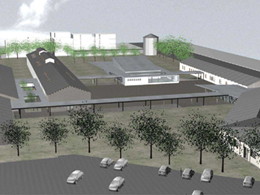
16 August, 2011
Project Suggestion for Reusing KOMDE’s industrial complex in Trikala
Construction of a University education center.The process through which the abandoned industrial building could become a new educational center.
Students: Brazioti Evaggelia, Breda Maria
Supervisor: Adamakis Kostantinos
University of Thessaly_ Department of Architecture Engineering
Date of Presentation: 03/03/2011
Description of the existing building
The Vehicle - Machine and Public Construction Center industrial complex (KOMDE) is located in the town of Trikala in Thessaly and more specifically in the Saraya area in the southwest of the town. Its initial function started in 1936 and it was the central construction site of the Henry Boot and Sons Limited Company, which undertook the project of drying the lakes in Thessaly before the World War II era.
It is a compact plot of land of 156.000 m2 .The building site consists of 11 buildings and the majority of them remain almost intact.
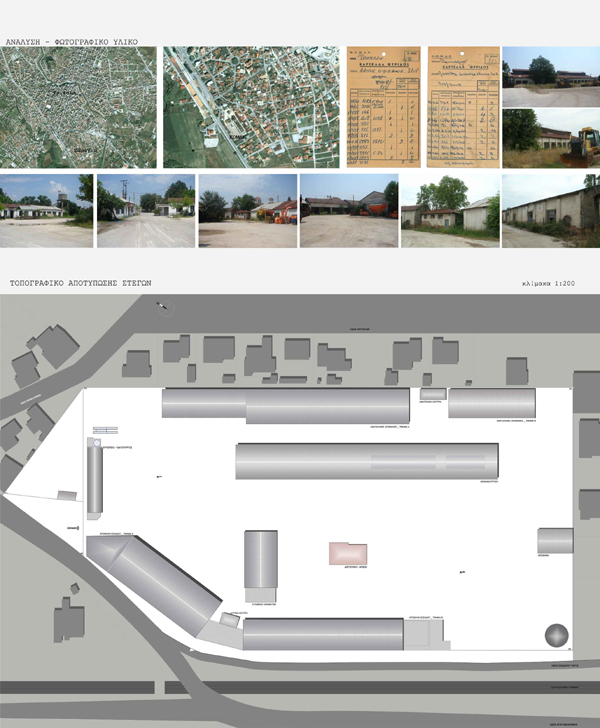
The buildings of the complex are distinguished by a unique industrial architectural design of a rectangular ground plan and oblong form.
Their floor plan is of rectangular elongated transverse partitions, which create storerooms for machines, labs and design offices.
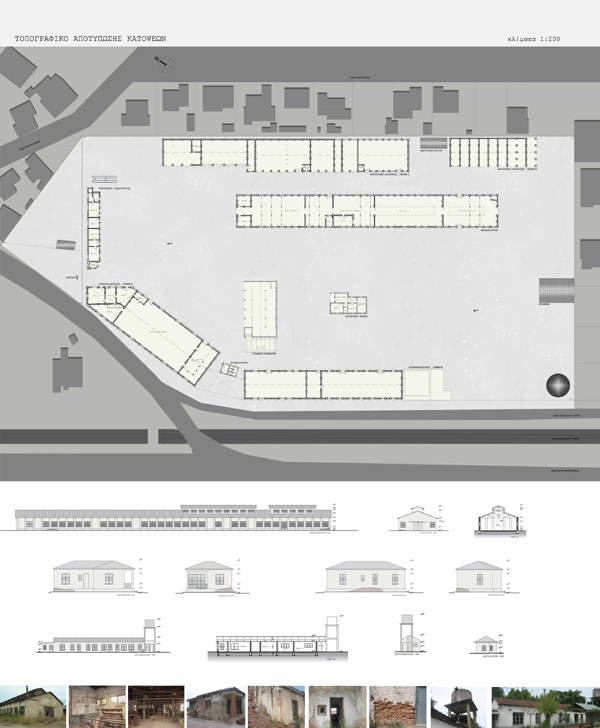
All the buildings are constructed by bearing walls of solid bricks that are reinforced by pillars every 2,00-3,00 meters apart.
The windows and the doors are placed among the pillars. The frames are made of wood and of planks and the window frames are panelled and glazed.
Wooden trusses are placed on the pillars in order to support the roofs. The coating of roofs is of corrugated sheet that is attached to wooden purlins.
In addition, the building floors are layered with reinforced concrete, while the majority of the buildings are coated.
The building that is used as a machine shop is the central building of the complex due to its location and function; the machine shop is the main place in which the repairs and the production of the mechanical parts take place. Moreover, it is housed under a pitched roof, which has two overhead skylights located in the area of kilns and foundry.
It is estimated that the KOMDE's machine shop is not only one of the most well known machine shops in the country but also one of the few so well preserved.
Its architectural design follows the stereotypical architecture of similar industrial buildings that has been applied from late 19th century up to early 20th century.
Suggestion
As far as the reuse of KOMDE's complex is concerned, our suggestion is that it could be used as an educational facility. More specifically, the construction site could be turned into two TEI (Technological Education Institutions) buildings that could house the already existing (since 2007) departments of TEI in the town of Trikala; the Department of Building Renovation and Restoration and the Department of Construction Works.
Nowadays, the above mentioned departments operate with great difficulty and it is possible that they would be relocated due to the lack of appropriate facilities. Since these two departments share not only their course of studies but also their needs for classrooms and labs it would facilitate the use of the premises by all students and staff with great success.
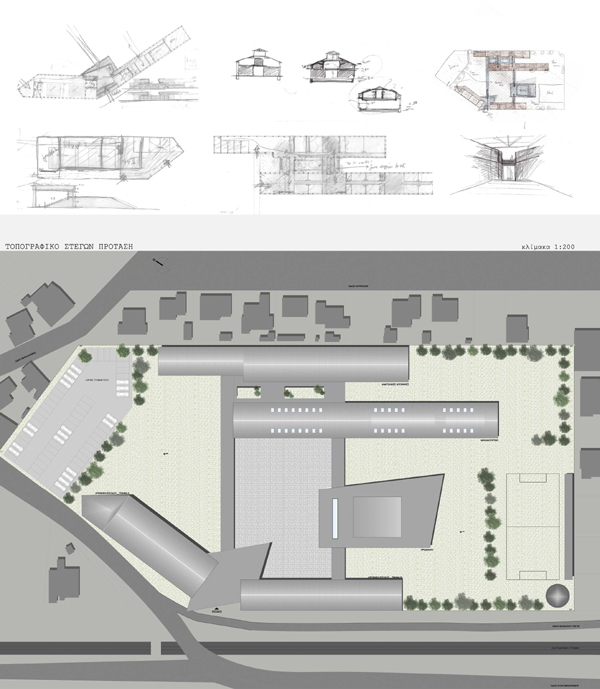
As regards the reuse of the complex, the maintenance of the building that was used as a machine shop is recommended, as well as the two sections of the storehouse entry and the biggest part of the eastern storerooms. In particular, both of the departments' registries are placed in the storehouse entry. We reached this decision bearing in mind that the students will save time and energy as they will not have to enter the rest of the premises when they want to head to the registry. Moreover, places for more general use such as: the library and the computer room are created in the remaining space.
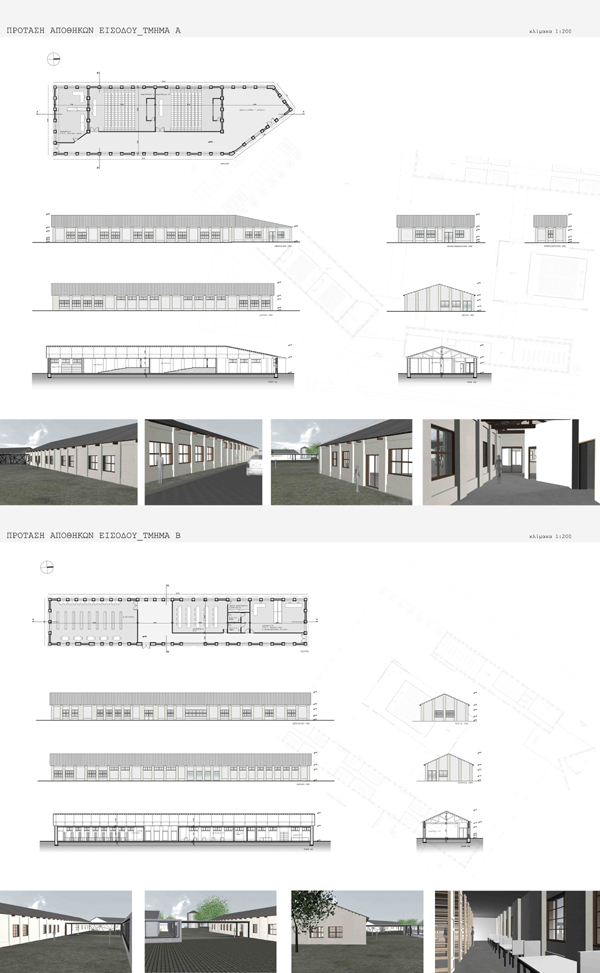
In addition, the teaching rooms are placed in the space that the machine shop is housed. In this way, we can take advantage of its great internal height and create a loft for the teachers' offices that would be in the same building as the classrooms for easier access. In order to achieve this, we lower the level of the building up to -50m and as a result we manage to increase the height in the internal part of the building. Furthermore, we build a new wooden roof and we place the trusses higher than the original one. The loft and the staircases are made of metal and as far as the roof is concerned, we install skylights that provide adequate lighting and ventilation to the offices.
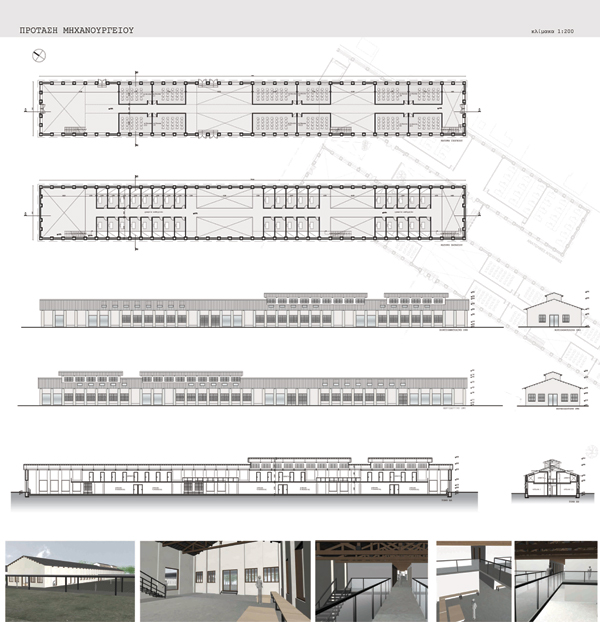
Finally, the eastern storehouse building could house the departments' labs along with the laboratory teachers' offices. This decision is based on the need to connect the laboratories with the classrooms.
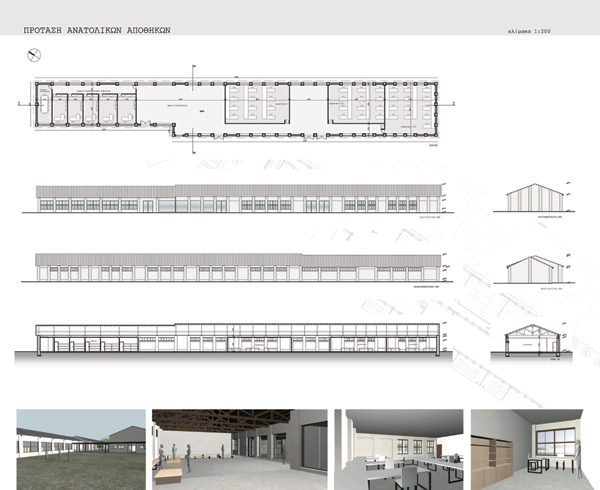
While the original buildings maintain their basic form as regards the façade and the floor plan, we proceed with the remodeling of the openings such as windows and doors so as to cover the contemporary needs. Moreover, most of the buildings have large sun lounges instead of windows, mainly in between classrooms and in the corridors. The pillars in each building are reinforced with molded concrete for sufficient static function. What's more, the wooden trusses which are used in the roof framing system, are covered only with a corrugated sheet. The internal partitions are new and they are constructed from 10 cm thick plasterboard. The internal brick walls are kept intact as long as they contribute to the layout of the premises.
In addition, a brand new building that will house the single amphitheater of the departments, the cafeteria and the foyer, is manufactured in the existing plot of land. The industrial machinery that has been found in the complex is put on display in the surrounding area in order to create a link between the modern building and its past as well as to provide the visitor with the opportunity to find out about the history of KOMDE's construction site. The new building is constructed from simple and contemporary materials so as to be in harmony with the existing buildings; metal pillars and beams that support the concrete slab are placed in the interior. Furthermore, the amphitheater is sheltered under a sloping roof which matches the seating slope and is also made of metal pillars, sheet metal and coated concrete.
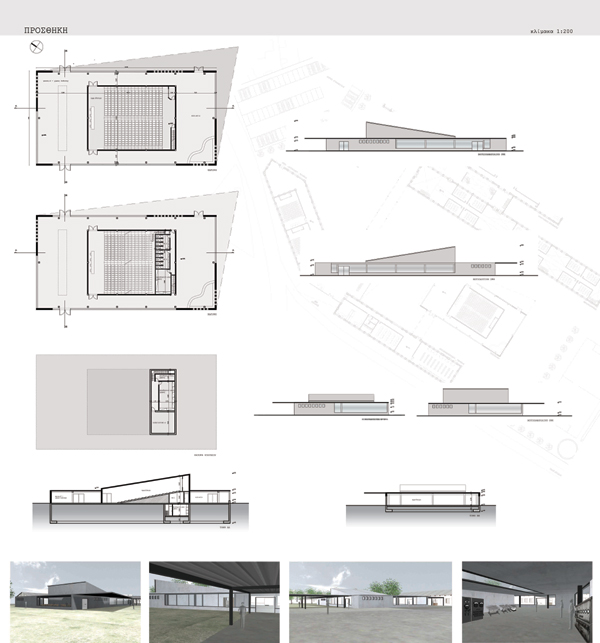
The exterior design
Between the two parts of the storehouse entry we construct a light metal construction which serves as the main entrance to the complex.
A covered walkway starts inside the entrance that extends from the machine shop into the eastern storehouses. The same type of walkways starts from the addition and connects it with the machine shop and the storehouse entry. The walkways are manufactured from metal pillars and beams that are overlaid by concrete slab. By constructing such walkways, we succeed in connecting the buildings together and consequently, we create a single education complex.
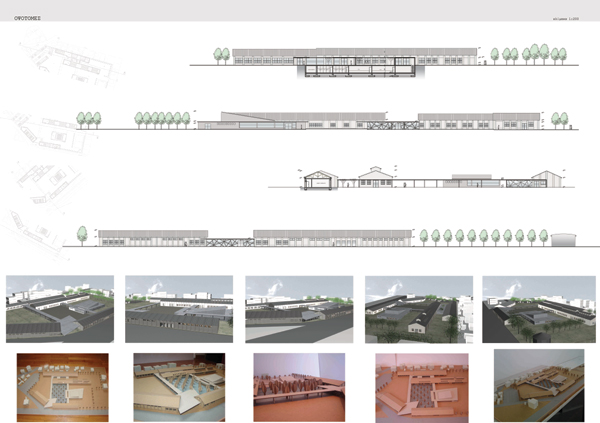
The need for communication between the machine shop and the eastern storehouses, as they house the teaching classrooms and the laboratories, leads to the construction of an enclosed roof linking these buildings.
Moreover, there is a free triangular space in front of the gate of KOMDE that we could use it in order to create an outdoor parking spot. We also plant a line of trees along the front gate's wall so as to hide the view to the parking spot from the inside. Lines of trees are planted around the perimeter of the plot, wherever this is possible in order to hide the view of the neighbouring buildings.
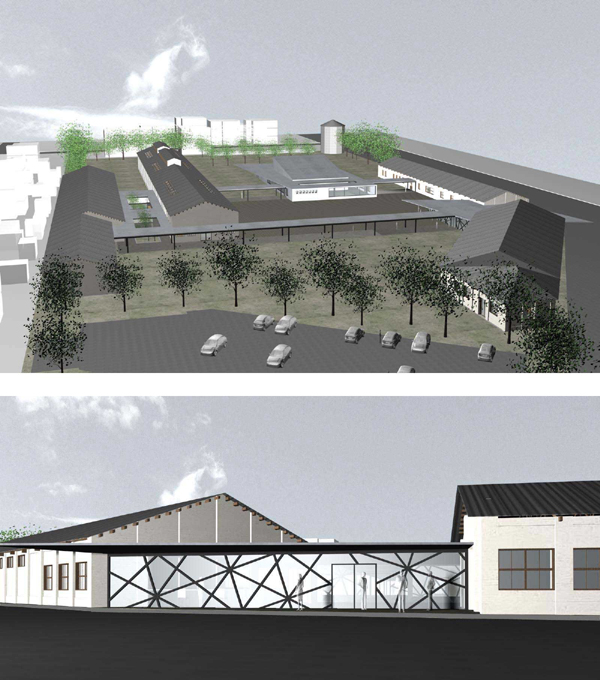
Furthermore, a courtyard is created between the walkways that connect the buildings and the rest of the area is planted so as to create a green space.
In conclusion, our main concern was to respect and preserve the history of the original buildings, while at the same time we followed distinct architectural designs that point out the contemporary era of its construction. Our primary goal for doing this, was that the new complex will constitute a new landmark for the town inextricably linked with its past.
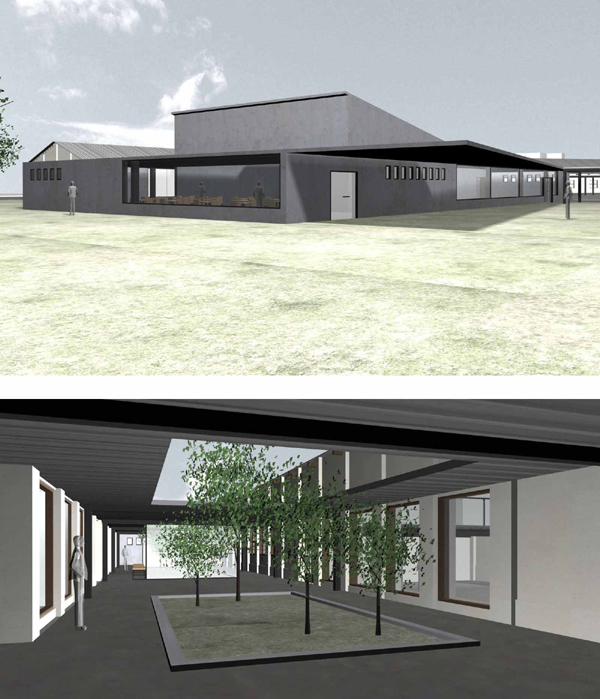
Related articles:
- Industrial Building on the fringes of Attiki Odos ( 15 November, 2009 )
- MEDICAL INSTRUMENTS FACTORY AT RAFINA, ATTICA ( 20 October, 2009 )
- Reutilisation of the building T.A.O.L. in Lefkada ( 23 June, 2010 )
- Routes in the paths of emery ( 01 February, 2011 )
- Urban integration and reuse of the former paper industry of Ladopoulos in Patras ( 20 February, 2011 )
- The old factory of Azel ( 04 April, 2011 )
- Restoration and reuse of the Tzivre silk mill in Soufli ( 14 June, 2011 )
- Mining Museum in Serifos ( 15 February, 2012 )
- Multi-space of Meditteranean Diet in metropolitan park in Goudi ( 05 March, 2012 )
- Subverting the non use ( 26 March, 2012 )
- Cultural Park in inactive lignite mines of Ptolemaida ( 27 September, 2012 )
- Winery in Nemea ( 01 May, 2012 )
- Industrial landscape in Aliveri ( 16 August, 2013 )
- Memory nd urban sityscape ( 24 May, 2013 )
- Decontamination and Production Mechanism ( 05 February, 2014 )
- Reformation and rehabilitation of an inactive quarry, with spatial location of uses for Tourism, Recreation and Environmental Education ( 10 February, 2014 )
- Redesigning the silo at the historic Allatini Mills ( 09 May, 2014 )
- Restructuring the Industrial Landscape ( 19 July, 2014 )
- inte[R]outes ( 11 December, 2014 )
- Lato and Kekrops Quarries: a walk in the residual landscape ( 28 January, 2015 )
- Print your utopia ( 07 February, 2015 )
- ADAPTIVE REUSE OF A FORMER PAPER FACTORY IN AIGIO AND CONVERSION TO REHABILITATION CENTRE FOR DISABLED PEOPLE ( 12 August, 2015 )










